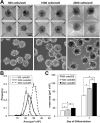Systematic analysis of embryonic stem cell differentiation in hydrodynamic environments with controlled embryoid body size
- PMID: 22609810
- PMCID: PMC4459715
- DOI: 10.1039/c2ib00165a
Systematic analysis of embryonic stem cell differentiation in hydrodynamic environments with controlled embryoid body size
Abstract
The sensitivity of stem cells to environmental perturbations has prompted many studies which aim to characterize the influence of mechanical factors on stem cell morphogenesis and differentiation. Hydrodynamic cultures, often employed for large scale bioprocessing applications, impart complex fluid shear and transport profiles, and influence cell fate as a result of changes in media mixing conditions. However, previous studies of hydrodynamic cultures have been limited in their ability to distinguish confounding factors that may affect differentiation, including modulation of embryoid body size in response to changes in the hydrodynamic environment. In this study, we demonstrate the ability to control and maintain embryoid body (EB) size using a combination of forced aggregation formation and rotary orbital suspension culture, in order to assess the impact of hydrodynamic cultures on ESC differentiation, independent of EB size. Size-controlled EBs maintained at different rotary orbital speeds exhibited similar morphological features and gene expression profiles, consistent with ESC differentiation. The similar differentiation of ESCs across a range of hydrodynamic conditions suggests that controlling EB formation and resultant size may be important for scalable bioprocessing applications, in order to standardize EB morphogenesis. However, perturbations in the hydrodynamic environment also led to subtle changes in differentiation toward certain lineages, including temporal modulation of gene expression, as well changes in the relative efficiencies of differentiated phenotypes, thereby highlighting important tissue engineering principles that should be considered for implementation in bioreactor design, as well as for directed ESC differentiation.
Figures




Similar articles
-
Hydrodynamic modulation of embryonic stem cell differentiation by rotary orbital suspension culture.Biotechnol Bioeng. 2010 Feb 15;105(3):611-26. doi: 10.1002/bit.22578. Biotechnol Bioeng. 2010. PMID: 19816980
-
Uniform Embryoid Body Production and Enhanced Mesendoderm Differentiation with Murine Embryonic Stem Cells in a Rotary Suspension Bioreactor.Methods Mol Biol. 2016;1502:63-75. doi: 10.1007/7651_2016_354. Methods Mol Biol. 2016. PMID: 27115505
-
Fluid shear stress pre-conditioning promotes endothelial morphogenesis of embryonic stem cells within embryoid bodies.Tissue Eng Part A. 2014 Mar;20(5-6):954-65. doi: 10.1089/ten.TEA.2013.0243. Epub 2014 Jan 24. Tissue Eng Part A. 2014. PMID: 24138406 Free PMC article.
-
Engineering the embryoid body microenvironment to direct embryonic stem cell differentiation.Biotechnol Prog. 2009 Jan-Feb;25(1):43-51. doi: 10.1002/btpr.139. Biotechnol Prog. 2009. PMID: 19198003 Free PMC article. Review.
-
The multiparametric effects of hydrodynamic environments on stem cell culture.Tissue Eng Part B Rev. 2011 Aug;17(4):249-62. doi: 10.1089/ten.TEB.2011.0040. Epub 2011 May 25. Tissue Eng Part B Rev. 2011. PMID: 21491967 Free PMC article. Review.
Cited by
-
Emerging strategies for spatiotemporal control of stem cell fate and morphogenesis.Trends Biotechnol. 2013 Feb;31(2):78-84. doi: 10.1016/j.tibtech.2012.11.001. Epub 2012 Dec 5. Trends Biotechnol. 2013. PMID: 23219200 Free PMC article. Review.
-
Osteogenic embryoid body-derived material induces bone formation in vivo.Sci Rep. 2015 May 11;5:9960. doi: 10.1038/srep09960. Sci Rep. 2015. PMID: 25961152 Free PMC article.
-
Statistical analysis of multi-dimensional, temporal gene expression of stem cells to elucidate colony size-dependent neural differentiation.Mol Omics. 2018 Apr 16;14(2):109-120. doi: 10.1039/c8mo00011e. Mol Omics. 2018. PMID: 29659650 Free PMC article.
-
Impaired bone formation in Pdia3 deficient mice.PLoS One. 2014 Nov 18;9(11):e112708. doi: 10.1371/journal.pone.0112708. eCollection 2014. PLoS One. 2014. PMID: 25405762 Free PMC article.
-
Concise Review: Stem Cell Microenvironment on a Chip: Current Technologies for Tissue Engineering and Stem Cell Biology.Stem Cells Transl Med. 2015 Nov;4(11):1352-68. doi: 10.5966/sctm.2015-0095. Epub 2015 Oct 8. Stem Cells Transl Med. 2015. PMID: 26450425 Free PMC article. Review.
References
Publication types
MeSH terms
Substances
Grants and funding
LinkOut - more resources
Full Text Sources

